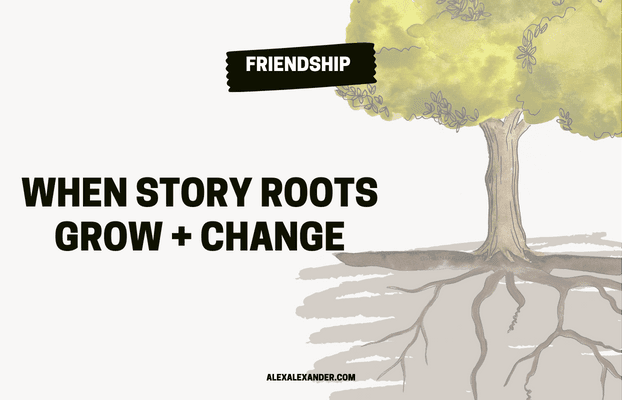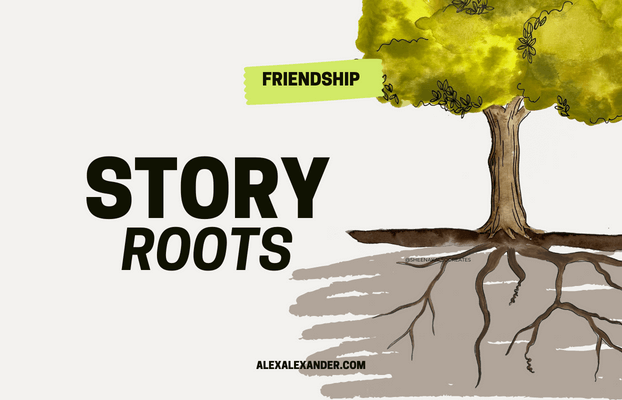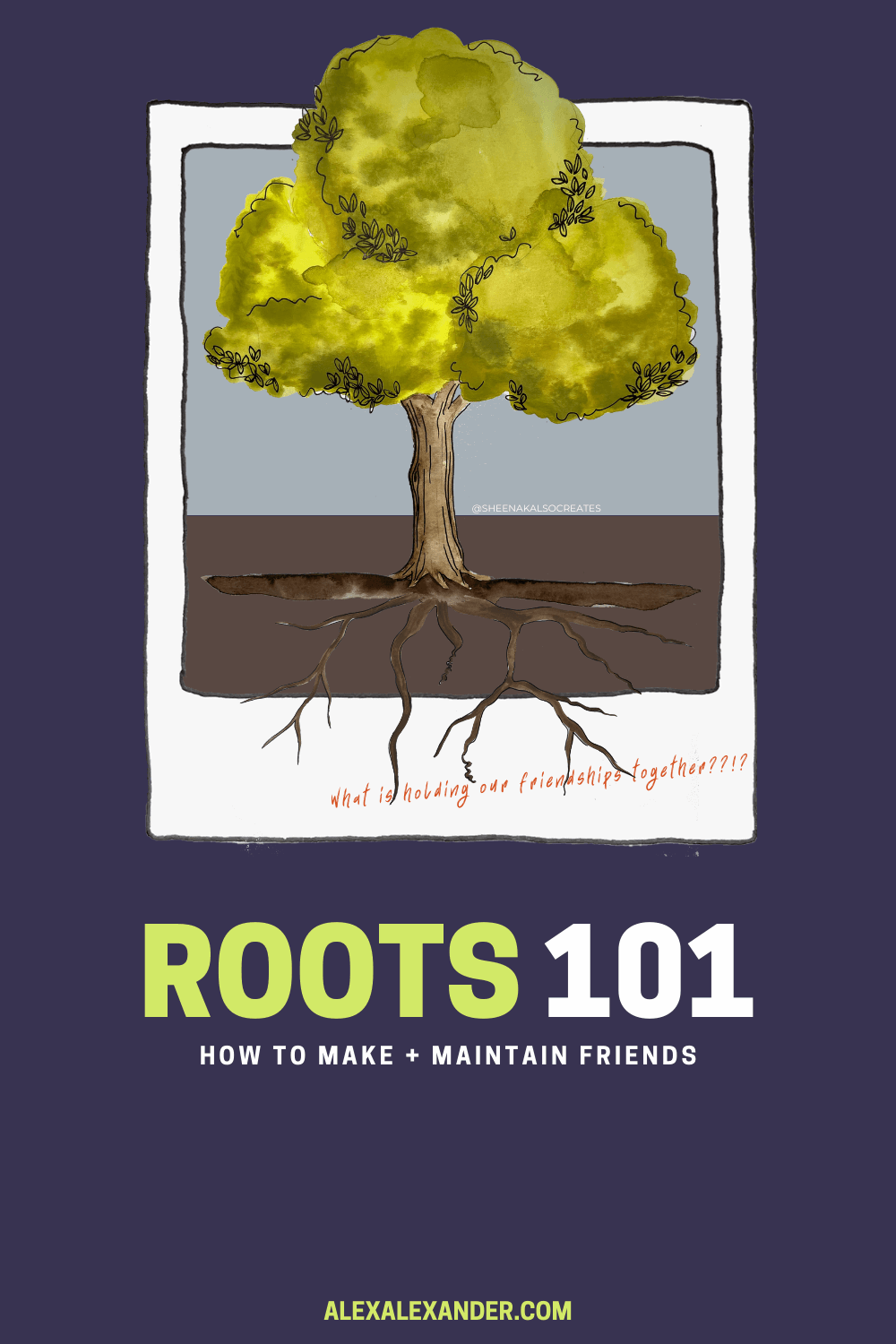
Want to build lasting friendships? It’s helpful to understand what holds your friendships together if you want them to last – ROOTS.
Your friendships are like a tree.
A tree starts as just a seed (or any of the other ways that the laws of nature say, but I haven’t read up on) or in real life, a chance encounter that develops a few roots. Over time and with the proper nourishment, that tree will grow and flourish. Without the appropriate nourishment, it will stop growing, lose some leaves, and even die.
Those old established trees that have been in the ground for decades – can last longer between water and sun. They’ll make it through the winter or a drought most years, but a massive storm might push the tree past its limit.
A dear friend of mine even came up with a metaphor. It has to do with cross-pollination, but we’ll save that for another time.
Standing outside and admiring the tree, it might look like it’s doing great, but what matters is how the tree feels. Let me explain.
PODCAST EPISODE! I recorded an entire episode on roots and how they play out in our lives. Listen here.
Do you have any house plants?
Sometimes you have to repot the tree because even though it looks fine when you walk past it daily, the roots hidden inside the pot aren’t healthy. They have outgrown their pot, were overwatered, or perhaps have root rot.
All to say, a tree can look fine to the casual passerby, even if it doesn’t feel okay.
Day to day, the tree might look the same. One day you walk past the tree. Stop and take a step back and notice how much the tree has changed in the past year. You open an image of the day you brought the tree home; sure enough, the tree has grown quite a bit.
It’s hard to see the daily change.
That would require you to dig into the soil and watch as each root has grown, died, and entangled.
Roots will change in all sorts of ways. They will grow – longer, more robust, and grow offshoots. The roots will also entangle, wither and perhaps die.
The roots are the most important part. A leafless tree with a healthy ball of roots might look like a stump in a pot, but it has a chance to regrow with the proper nourishment. However, a tree with leaves but neglected roots – well, it’s only a matter of time.
The core of friendship is those roots. They allow the tree to weather storms, grow, stagnate, and adjust to its surroundings creating long-lasting friendships.
Finally, if the tree dies and you pull it from the ground, there will likely be some roots that remain in the earth – a sign that the tree was there.
So what are the roots?
Roots are
- Beliefs
- Expectations
- Evidence
- Small Details
- Memories
- Intimacies
- Actions
- Interests
that are holding our friendships together.
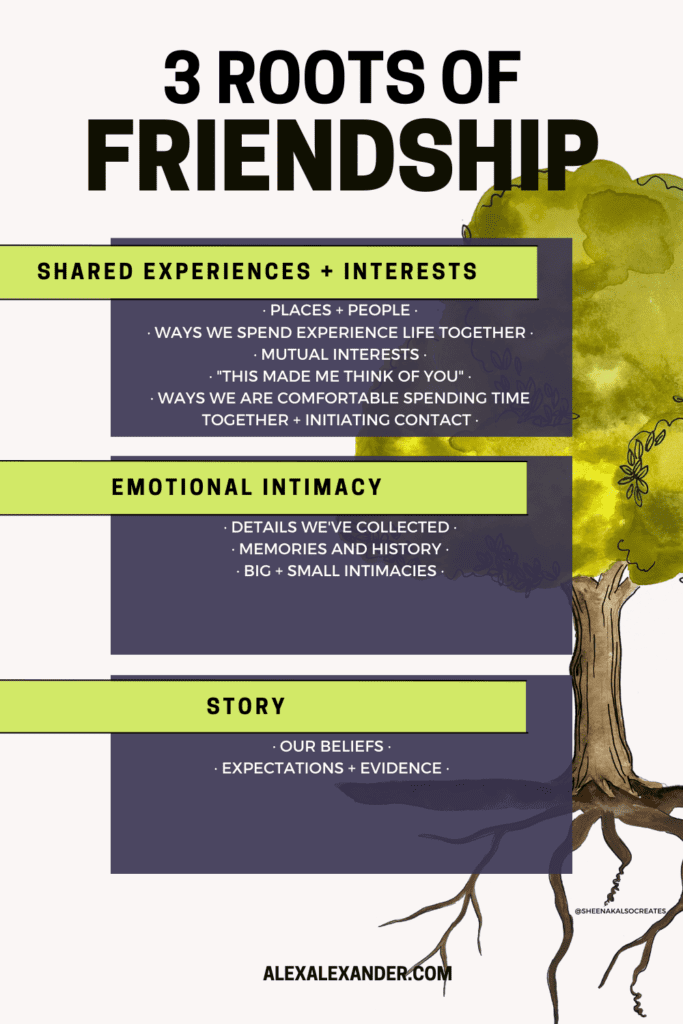
PODCAST EPISODE! I recorded an entire episode on roots and how they play out in our lives. Listen here.
All of the roots above fit into three categories of roots:
- Story Roots – Beliefs, expectations, evidence
- Emotional Intimacy Roots – Small details, memories, intimacies
- Shared Experience Roots – Actions, shared experiences, interests
Want to understand why your friendship feels the way it does? Take a good look at the roots.
Hard to find ways to spend time together?
A shared experience root has probably withered.
Feel like you should be able to ask a friend for a favor but don’t trust they’ll show up?
A story root doesn’t have the evidence to make the root feel sturdy.
See an old co-worker and immediately want to text your work best friend?
That’s your emotional intimacy roots.
People change, therefore relationships change. We need a way to discuss and understand the change.
Without further ado, let’s dive into the three kinds of roots.
Shared Experience Roots

Shared Experience Roots are often (but not always) the first roots you develop with new friends. With lasting friendships, you’ll constantly grow new roots and mourn roots that die.
Our connection points
- You both work at the same company.
- You both are members of the same book club.
The ways we spend time together and experience life together.
- The friend you go out to the bars with every Saturday night
- You two look forward to boxing classes together.
The interests that make us think of each other.
- Sharing an article about friendship with me because I write about friendship.
- You both love to cook, so you share a recipe you just enjoyed.
The mutual activities/interests you share
- You both love to read and text about books you just finished.
- Texting a friend who also played soccer in high school (not on the same team) about your high school team making the state playoffs.
The ways we are comfortable spending time together.
- Asking a co-worker to happy hour after work.
- Inviting one of your oldest friends to your parents’ anniversary party.
The reasons we initiate contact.
- The reasons we initiate contact
- You just joined a running group and met a new friend. You’ve never really talked outside of your weekly club meetings, but send a random text because the running store you both love is having a sale, and you don’t want them to miss out.
Some friendships will have one shared experience root.
That root might be simple or solid and full of offshoots.
There’s nothing wrong with a single root shared experience root friendship. If you want to build a lasting friendship that transitions easily if that root were to die, be mindful of creating a variety of ways you connect. For example, your work bestie getting a new job or your gym friend getting injured.
Emotional Intimacy Roots

Emotional intimacy roots are the details we’ve noticed about friends, our memories, shared history, and big + small intimacies.
After we are present with friends in our shared experience roots, we go home, and those moments are over, but we can tuck away the things we’ve noticed about our friend, the memories we’ve made, and the intimacies we’ve shared for later.
Either way, emotional intimacy roots are rooted in the past.
The memory could be as recent as yesterday or one from decades ago.
We’ve talked quite a bit about how people change and, therefore, relationships change.
Emotional intimacy roots hold the past. We tap into our emotional intimacy roots – the things we know about our friends – to act in ways that make our friends feel cared for and seen.
Emotional Intimacy Roots are:
The small details we collect about a friend
Their preferences, boundaries, experiences, perspectives.
- Knowing a friend loves donuts and surprising them with their favorite kind.
- Acknowledging a friend’s boundaries when you send an invite: “Hey! We are having J over for dinner on Sunday. I know you normally take Sunday nights to yourself, but I just wanted to send you an invite in case you wanted to join.”
The memories you’ve made together.
You have memories with your newest friendships and hearty roots with your long lasting friendships.
- Regaling each other with stories from the party last night. Telling a friend how much you loved watching them let loose on the dance floor.
- Reliving your high school football glory days with one of your oldest pals.
Shared history
You’ll discover shared history with new friends and might even uncover facts with lasting friendships.
- Regaling each other with stories from the party last night. Telling a friend how much you loved watching them let loose on the dance floor.Texting a friend about how your High School soccer team made the state finals. You both played soccer but didn’t know each other when you played in high school.
- Realizing that you share a mutual friend that you know from different places. One of you was that friend’s co-worker right out of college. The other person met the mutual friend at a networking event recently.
Small intimacies
Sharing a win, acting carefree, letting someone help us with something small, telling a friend you enjoyed your time together, and many more.
- Sharing the news about your promotion!
- Even though you don’t have many dancing skills, laughing with total disregard and letting loose on the dancefloor.
Big intimacies
Trusting a friend with a secret, asking for help, calling in an emergency, trusting a friend with our kids, talking about a big problem, sharing that we’ve been struggling with our mental health, and many more.
- Checking in on a friend on the anniversary of a traumatic event. Not many people know, but you want to ensure that they know you are thinking of them.
- A friend asks you to be their kid’s emergency contact at school.
We build up emotional intimacy roots by spending time together, sharing, searching for mutual history, paying attention to the small details about our friends, and making a mental note of that information. That can be quite a bit of information in a lasting friendship!
Emotional intimacy roots help us act in ways that make our friends seen and connected to us. They can also be the catalyst for connection because they cause everyday experiences to make us think of each other and reach out.
Story Roots
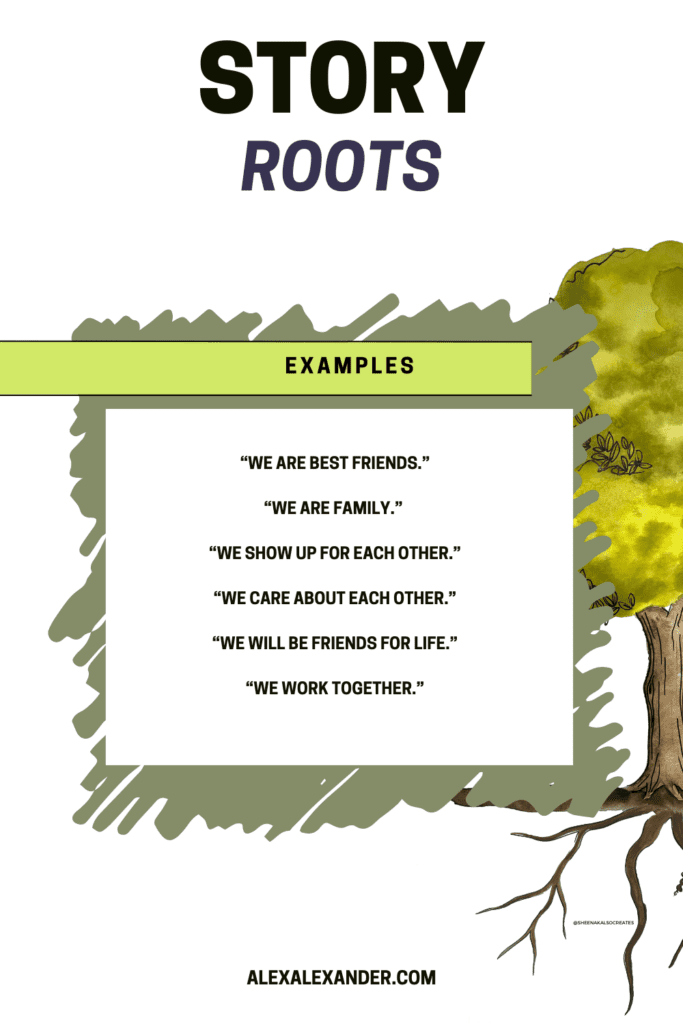
Our beliefs about our friendship.
Beliefs we choose.
Beliefs we have because of societal stories and pressures.
Beliefs we have because other people tell us they are beliefs we should hold.
Our beliefs inform our expectations.
Our expectations are confirmed or contradicted by evidence found in our actions.
Story roots are often the last to develop with friends, but that isn’t always the case. Sometimes we have story roots with someone before we’ve ever met them.
How could that be?
Well, story roots are our beliefs about our relationships. We often develop our beliefs on our own, but sometimes other people or society tell us what to believe, and we choose to do so.
Story Roots are
- “We are best friends.”
- “We are family.”
- “We show up for each other.”
- “We care about each other.”
- “We will be friends for life.”
- “We work together.”
- “That friend likes me because they keep asking to play.”
- “We were friends before we were even born. We’re friends for life.”
- “We are sisters-in-law now.”
Did any expectations pop in your head as you read those story roots?
For example, if you believe “we are best friends,” doesn’t that come with a picture of how that person acts in your life?
- Where did those expectations come from?
- Were they mutually agreed upon?
- Did you observe them in other friendships?
- Did someone tell you to expect those actions?
- Did you have a conversation with your best friend to ensure you were on the same page about your expectations?
The more evidence you notice that aligns with your expectations, the stronger your story root will be.
Evidence you notice that contradicts your expectations + story root will weaken your story root.
The more time we spend with friends either in person, virtual, or just connecting however we can (story roots)– the more opportunities we have to act in ways that confirm (or detract) from our story roots.
The more emotional intimacy we have, the easier it is to act in ways that confirm our story roots.
Story roots are our beliefs.
Our beliefs inform our expectations.
Actions either confirm or contradict our expectations.
We take the actions during our shared experience/ interest roots, often using our emotional intimacy roots.
And so, the cycle continues.
Story roots, just like all the other roots, change, wither and die.
We need to be checking in on our story roots and determining if they are still the beliefs that feel right for our friendships or if expectations need to shift for a particular story root.
That was a fast and furious primer on roots. There will be dozens of posts that dive deeper:
- I’ll be sharing deep dives into each kind of root.
- Examples of roots shifting and changing.
- Stories of roots dying.
- Real-life examples of people putting in the work to make friendships last.
- Deep dives into how individuals determine what being a true friend means to them and the roots of that.
- Conversations about how society has led men and women to focus on developing roots differently.
- + many more posts.
The key to long-lasting friendship is tending to the roots, so we’ll dive deep into all your questions over time.
Curious how to keep a friendship strong? Read about the other types of roots.
